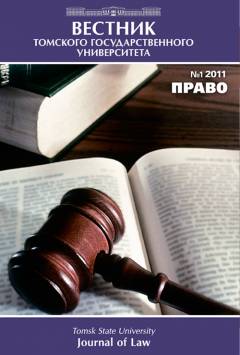Individual criminological prediction of the behavior of juveniles sentenced to imprisonment
The author substantiates the necessity to create the methods for criminological prediction of the behavior of juveniles sentenced to imprisonment. He provides the data on the dynamics, condition and structure of delinquency of juveniles sentenced to limitation of liberty. The above delinquency consists of: crimes against property- 50%, crimes against person- 17% and crimes against people's health -7.3%, the relative share of all the rest crimes being not more than 0.5% totaling 11.2%. About 95% of all delinquents were sentenced to limitation of liberty for non-grievous crimes (45.1%) and crimes of medium gravity (49.6%), 4.8%- for grave and 0.5% for especially grave crimes. The following crimes prevail in the structure of new crimes committed by juveniles while they were serving their sentences to limitation of liberty as compared with the total mass of delinquents: unlawful hijacking of a car or another vehicle without intention to steal (60% against 25.4%), qualified deliberate destruction or injuring of property (5% against 0.4%), knowingly false information about terrorist acts (5% against 0.3%). However, the relative share of thefts (10% against 19%), robberies (5% against 11.2%) and deliberate health injuries of middle gravity (5% against 14.9%) has decreased. Extortion (about 4% against 4.5%) and crimes against people's health have approximately the same share. Thus, the number of delinquents sentenced to limitation of liberty for grave and especially grave crimes has increased up to 18.75% against 5.3% if all crimes. The author gives a criminological characteristic of those sentenced to limitation of liberty and separates the most criminogenic category from the viewpoint of their previous criminal activity. He examined 350 juvenile delinquents sentenced to limitation of liberty and registered with the probation departments in 2010-2014. Recidivism seems to occur among those delinquents who were previously sentenced to limitation of liberty for unlawful hijacking of a car or another vehicle without intention to steal, qualified deliberate destruction or injuring of property, knowingly false information about terrorist acts. 62.5% of recidivists did not work or study at the time of sentencing and criminal legislation does not provide for the possibility to combine the content of punishment with work or studies. The present article substantiates and formulates a number of proposals for the legislation development.
Keywords
несовершеннолетние, альтернативы лишению свободы, наказания без изоляции от общества, рецидивная преступность, ограничение свободы, juveniles, alternatives to imprisonment, punishment without isolation from society, recidivism, limitation of libertyAuthors
| Name | Organization | |
| Olkhovik Nikolay V. | Tomsk State University | law-tsu@rambler.ru |
References

Individual criminological prediction of the behavior of juveniles sentenced to imprisonment | Tomsk State University Journal of Law. 2015. № 4(18).